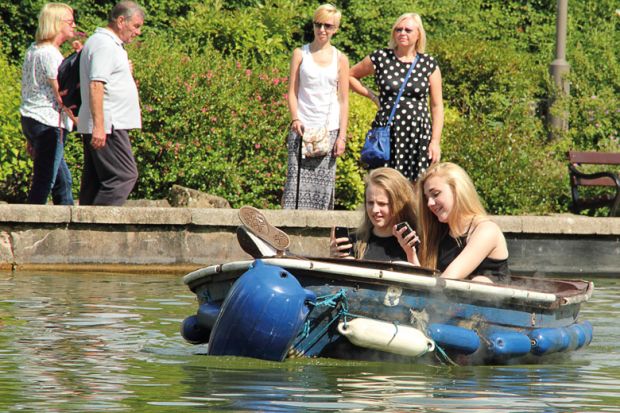The higher education world is used to technological advances. The majority of those developments probably come from original research cooked up in universities. So it’s hardly surprising that 379 of the 867 exhibitors at Bett 2016, the education technology trade fair held in London last week, were targeting the higher education sector with their products.
But even in a technology driven world, is there a limit to how much universities should be trying to digitise learning?
For Dave White, head of technology enhanced learning and lecturer in visual communication at the University of the Arts London, integrating technology into teaching has to take into account the fact that students still want to feel part of an institution – in both the physical and digital sense.
“I think it’s particularly important that the digital is seen as a place where students feel like they belong to the institution and they can connect with each other,” he told the audience at a talk entitled “What drives successful e-learning?”
“My worry is that as we get more and more efficient at e-learning and the digital, we provide more flexibility for the students, but in actual fact that alienates the students because they have less reason to turn up. It’s important to provide that flexibility, but one of the key things we find [is] that idea of being communal is what helps students feel like they belong to the institution.”
Speaking to Times Higher Education after the talk, Mr White added that lecturers have to appreciate that students still have traditional ideas about degree programmes, and learning should reflect this.
“For most people, including the students, a course [is still about] lectures, studio space. Quite often, the students have a more conservative view of what a course is than the staff,” he said. This reinforced his view that current undergraduates have anxieties around technology and their learning.
“What we see time and time again is that students do not consider themselves to be experts in technology in any way, shape or form,” he said. “Any institution that starts with the implicit idea that students feel like they’re reasonably technically adept – that will fail. Students look to the institutions to help them.”
His comments were reinforced by Brian Hipkin, vice-chair of the student services organisation AMOSSHE and dean of students at Regent’s University London, during his presentation.
“In my experience, largely, students don’t know what they don’t know,” he said. “Students are quite conservative with a small ‘c’ in terms of the use of social media [and] technology in…learning.”
“It comes down to good teaching. I genuinely don’t believe it’s a digital issue,” he said.
“I’m starting to see the pedagogies of the physical and pedagogies of the digital coalesce,” Mr White concluded. “I think we’ve got to a point with the digital where the technology works well, most people can get into it, and all it’s doing is highlighting the need for good teaching.”
Which newer technologies are helping to advance teaching and learning?
Flipped classrooms
Zoe Swan, senior lecturer in law at the University of Greenwich, said that in her teaching she often thinks about the ways she studied and trained to be a barrister and how the “knowledge-heavy subject base” of the field can disengage some students.
For Ms Swan, a finalist in the 2011 Law Teacher of the Year Award, using technology so that students can brush up on a topic before coming to a lecture has ensured that they remain engaged with a sometimes overwhelming subject.
“I try and look at student aims and learning outcomes and I try and make something engaging so it equips them with a skill base,” she said. Her software of choice is a video platform called Panopto, which enables her to create voiced-over PowerPoint presentations of up to 30 minutes about the key concepts in a topic. The videos can be viewed by students in a variety of ways, including on a smartphone, enabling them to come prepared to full teaching sessions.
E-assessment
A 2013 Jisc study found that there was a “compelling case” for the electronic submission of students’ work.
But Kevin Morton, senior lecturer in physical education at the University of Brighton, who presented at Bett 2016 on the issue of assessment, told Times Higher Education that universities should be going further than “simply digitalising the mode of submission and marking”.
“In order for HE to really captivate creativity and stretch the thought processes of young minds, while meeting rising expectations, institutions may need to look further into digitalising the journey and the destination of assessment, ie, the process and product,” he said.
Linda Creanor, head of blended learning at Glasgow Caledonian University, said giving students feedback electronically was becoming ever more important. “Increasingly, our staff are moving towards e-submission, e-marking and e-feedback. The students who get feedback online really appreciate it,” she said.
后记
Print headline: ‘Students aren’t always experts in technology’




